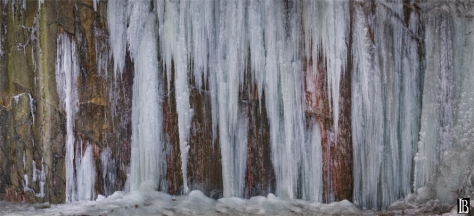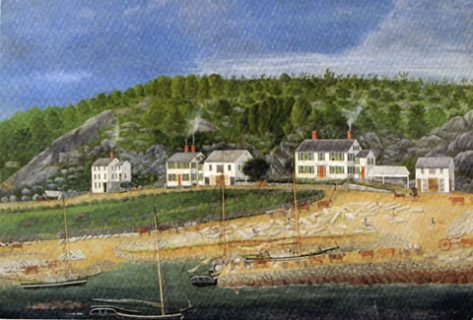The view of Haskins Block which I posted yesterday was a closeup from the following image by Charles Cleaves – it is from the boulders above Granite Street (at the corner of Beach & Granite).
With the recent interest in Knowlton’s Wharf, this view reigns supreme in my interest; the wharf space is almost jaw-like in opening
toward the backdrop of the town. If you open up the image full size you’ll be able to see the fenced garden in the foreground. I think there are many rows of thriving pole beans! And the lower left appears to be a large drying rack – which I think was for the drying of “sea moss farina.” (Another topic!)
Finally, I just want to call brief attention to the stamp signage in the lower right hand corner: LB -after C.C.
[Leslie Bartlett after Charles Cleaves]
Monthly Archives: January 2014
A Novel Idea -Building the Bigger Bo(u)lder Rockport
Sam Colburn’s previous post of Haskins Block elicited
comments which ranged from loss over the old style “original Rockport” building (replaced by the Shaolin Lui), and additional sentiments over the way in which the old falls down before the new.
Look at the huge, open inviting space behind the Haskins Block…
then read the newspaper clip below!
 A Novel Idea.--It is talked of by Messrs. Haskins, to utilize their block on Main St. by enlarging it in the rear, putting on a hotel front facing the ocean, and using part of the present building for hotel purposes. The duplicated institution will thus face the sea for pleasure, and the street for business.
A Novel Idea.--It is talked of by Messrs. Haskins, to utilize their block on Main St. by enlarging it in the rear, putting on a hotel front facing the ocean, and using part of the present building for hotel purposes. The duplicated institution will thus face the sea for pleasure, and the street for business.
Cape Ann Advertiser 1879
Comment by Les – you have to understand, Rockport in 1879 was in a desperate race to keep up with Pigeon Cove. In 1879 there were over 500 HOTEL rooms in the Cove, Pigeon Cove was a self-sustained community which never bothered to look in the direction of Rockport. A Haskins Hotel would have been at least 50 years ahead of its time
Grazing the Pastures of History
“The past is a foreign country: they do things differently there.”
– L.P. Hartley, The Go-Between Above is a view of Dogtown Commons taken by Charles Cleaves on Sept. 14, 1913. He has had to lug his camera equipment up over “Pig On” Hill, set up near the cows and frame Whale’s Jaw in the background of his scene. He is using 5 x 7 glass plate negative technology. And when he returns home, he scratches the date on the negative plate. The plate is then stored in an envelope on which he enters the exposure settings, and time of day. (But not the names of the cows.)
Above is a view of Dogtown Commons taken by Charles Cleaves on Sept. 14, 1913. He has had to lug his camera equipment up over “Pig On” Hill, set up near the cows and frame Whale’s Jaw in the background of his scene. He is using 5 x 7 glass plate negative technology. And when he returns home, he scratches the date on the negative plate. The plate is then stored in an envelope on which he enters the exposure settings, and time of day. (But not the names of the cows.)
Dogtown today is completely grown over; nary a cow to be found.
I woke up this morning reflecting on how overgrown and overrun we are by our current technologies. It is so easy to make a brief Facebook comment, to look at an image, “like,” and move on. My grazing of our history here on Cape Ann finds me settling down in a unique pasture: my love of granite and subsequent national installations of my works have repeatedly placed me with a viewing public who know nothing of granite, or of quarrying , but who are entranced by the imagery displayed. They are intrigued by the stories the rock walls suggest.
 Overtime I have felt the hunger to connect – to tradition, to a personal past, to our community past. This connection is found through slow reflection. (Chewing the cud, the elusive slip of grass waving in the wind.) Like ice on a quarry wall, life gone by emerges, if only for a season.
Overtime I have felt the hunger to connect – to tradition, to a personal past, to our community past. This connection is found through slow reflection. (Chewing the cud, the elusive slip of grass waving in the wind.) Like ice on a quarry wall, life gone by emerges, if only for a season.
The way we walk through Dogtown today bears no resemblance to the way C. Cleaves walked in 1913.
The way in which we remember things today, bears little resemblance to the recall of generations past. To “Re-Call,” the past is a worthy effort, and can restore pride in the legacies of Cape Ann. I love the history of Cape Ann: granite, timber and fish reverberate as I walk the pathways of our “foreign country.”
Knowlton’s Corner
View at Knowlton’s Corner, Oil by Alfred J. Wiggin, circa 1854 This oil is on view at the Sandy Bay Historical Society Marine Room.
This oil is on view at the Sandy Bay Historical Society Marine Room.
I wanted to follow up on Tom Philbrick’s image post of the wharf with granite. The Wiggins painting (only 5 years after Rockport’s incorporation) provides us with a lovely glimpse of the density of trees we once enjoyed on Cape Ann. The quarry industry consumed and destroyed much of the old growth inner forestation of Cape Ann; so much so that coal became the chief source of heating for many Rockport & Gloucester residents. And so as the stone sloops went out loaded with granite, they inevitably returned with coal. Some of which the granite companies kept to run their steam engines, the rest was often delivered across Cape Ann.
… more comments on the morrow.
Before the “selfie” photo there was the “pixie” photo
Charles Cleaves’ daughter Virginia was photographed from the day she was born , right throughout being a young adult. And you can watch over the years and see the exasperation set in – for most of the images were done with glass plate negatives. No smartphone look at me! No snapchat. Set up time could be lengthy. Even for Charles.
This image of Virginia carries a visible trace of what would become a pout…
Homage to Charles Cleaves
Every photographer of Cape Ann is forever in the debt of Charles Cleaves. He photographed Rockport from 1890 right up to his death in 1935; beginning with small glass plate negatives he chronicled Rockport’s emergence from 19th Century to post WWI, and the influx of summer tourists. His daughter, Virginia Cleaves Little formed the Rockport Post Card Bureau. Many of the images we are feeling warm and fuzzy about in this FBook group were published by her.
 I first met Charles Cleaves in 1999 at the Sandy Bay Historical Society, where Cynthia Peckham opened a closet door to reveal over 2,000 glass plate negatives in a random pile. Over several months I would sit on the floor, slide a plate out, hold it up and say “Yes to scan,” “No, to save.” SBHS now has a scanned database of over 1800 Cleaves images.
I first met Charles Cleaves in 1999 at the Sandy Bay Historical Society, where Cynthia Peckham opened a closet door to reveal over 2,000 glass plate negatives in a random pile. Over several months I would sit on the floor, slide a plate out, hold it up and say “Yes to scan,” “No, to save.” SBHS now has a scanned database of over 1800 Cleaves images.
No matter where you might stand to take a photo, chances are Charles was there first, over 100 years ago. I have a fair grasp of his heritage; for the past decade I have produces the Rockport National Bank’s Historic Calendar, which continues to draw on Cleaves’ imagery.




